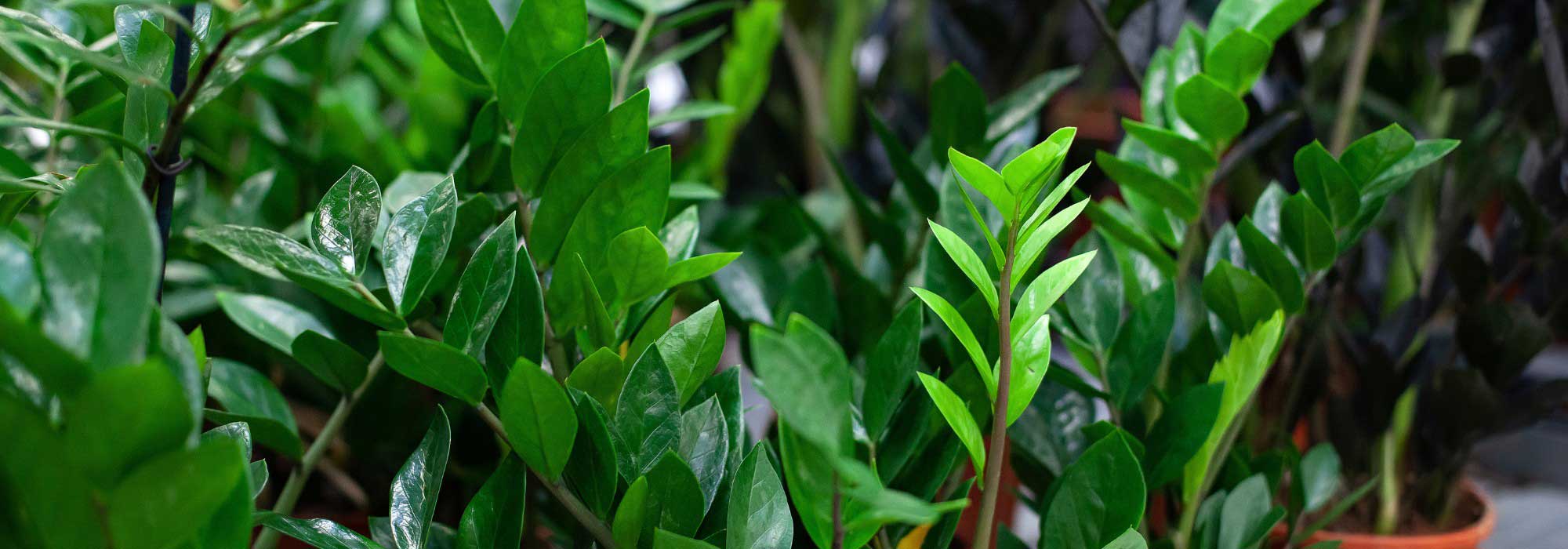
Zamioculcas: growing and care
Contents
Zamioculcas in a nutshell
- The Zamioculcas zamiifolia is native to East Africa, particularly Tanzania and Zanzibar.
- Its upright stems bear glossy and highly graphic leaves, deep green or black depending on the variety.
- It is an ideal indoor plant for beginners, very tolerant of varied growing conditions.
- It withstands drought, missed waterings, and low-light rooms.
- It fits perfectly into modern, minimalist, or tropical décors thanks to its structured habit.
A word from our expert
The Zamioculcas, often referred to as the “ZZ plant” or “Zanzibar gem,” is a houseplant native to East Africa. With its glossy foliage and elegant habit, it has secured a prominent place in modern interiors. It forms upright, slightly arching stems bearing ovate leaflets, arranged regularly along the stems, creating a very graphic effect!
The Zamioculcas zamiifolia combines aesthetics and hardiness, making it an ideal companion for those who wish to add a touch of greenery to their home without necessarily having a green thumb. With its long upright stems and deep green leaves, it brings a modern touch while evoking a tropical atmosphere.
In this article, we will explore the characteristics of the Zamioculcas, its various varieties, how to plant, care for, propagate, and even pair it with other plants to create a harmonious space. You will discover everything you need to know to grow and showcase this exceptional plant!
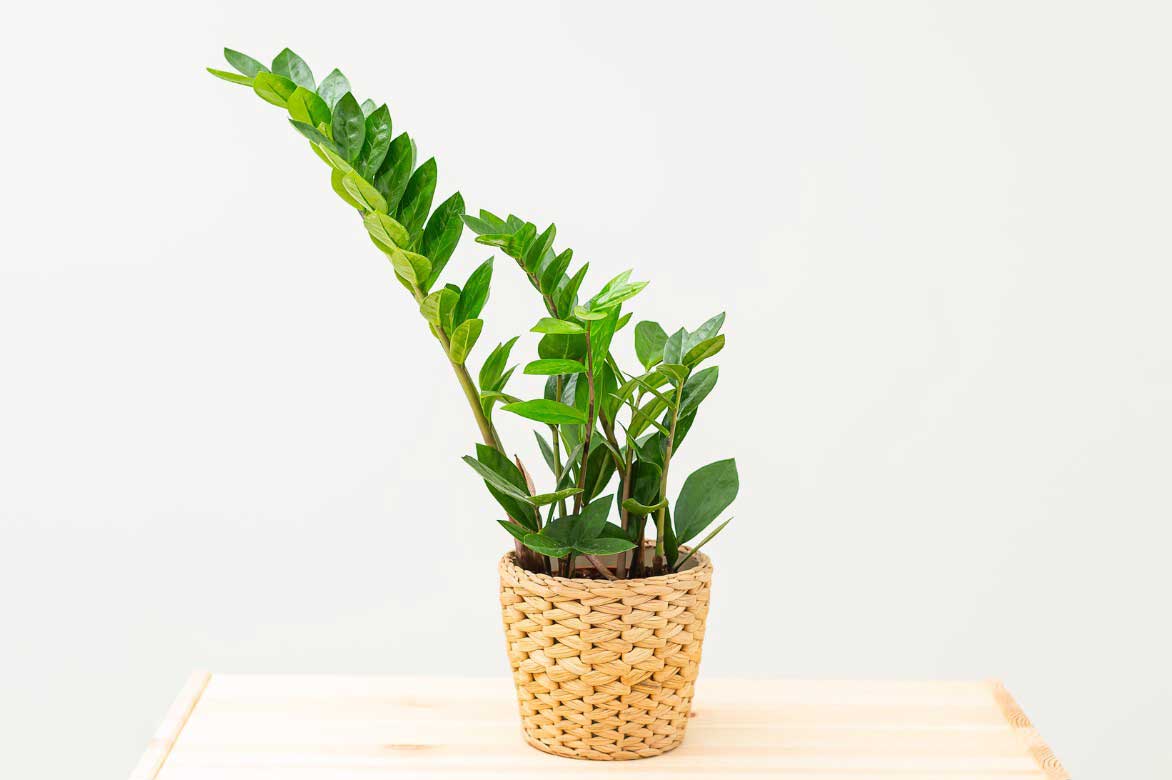
Description and botany
Botanical data
- Latin name Zamioculcas zamiifolia
- Family Araceae
- Common name Zamioculcas, ZZ plant, Zanzibar gem
- Flowering Rare indoors; small inconspicuous flowers in spathe, usually in summer
- Height From 60 cm to 1 m indoors
- Exposure Indirect light to partial shade, no direct sunlight
- Soil type Light, well-drained, potting soil for houseplants or cactus mix
- Hardiness Not hardy, minimum temperature 10 °C
The Zamioculcas zamiifolia is a rhizomatous perennial plant belonging to the Araceae family, just like philodendron or monstera. Native to the tropical and subtropical regions of East Africa, particularly Tanzania and Zanzibar, it is relatively drought-resistant and tolerates poor soils. This adaptability makes it an easy-going plant for indoor environments.
Zamioculcas has an upright and compact habit, with thick, fleshy stems that emerge directly from the base, forming a dense and symmetrical tuft. Each stem bears a series of ovate, glossy, and leathery leaflets, arranged alternately. This arrangement gives the plant a graphic and highly aesthetic appearance, often compared to a feather or a frond.
Indoors, the Zamioculcas can reach between 60 cm and 1 metre in height at maturity, making it an ideal size to dress a corner of a room, a shelf, or a desk. In its natural habitat, it can sometimes reach 1.5 metres tall, but it is rare for it to achieve such dimensions in a pot.
The foliage of the Zamioculcas is one of its major assets. The leaves are a deep green, glossy, and almost waxy, giving them a highly appreciated natural shine. Some varieties, such as ‘Raven’, even feature spectacular black foliage.
It is rare for the Zamioculcas to flower indoors. When it does, the flowering takes the form of a spadix cream-white to pale yellow (cone or spike-shaped), surrounded by a green spathe, leaf-like in shape. Its flowering is typical of the botanical family Araceae, which includes many other ornamental plants: Arum, Spathiphyllum, Dieffenbachia, etc.
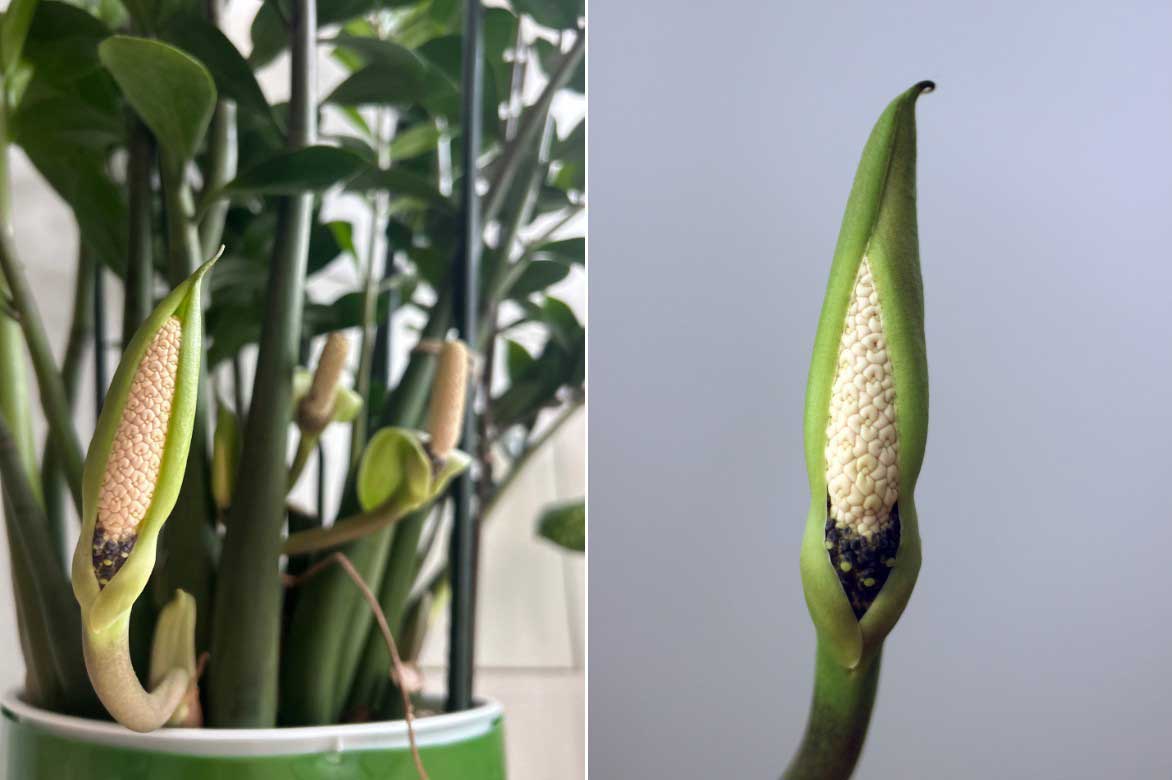
The flowering of the Zamioculcas
Note that the Zamioculcas is not hardy: it cannot withstand temperatures below 10 °C. However, it is extremely drought-resistant, thanks to its underground rhizomes that store water. This allows it to survive long periods without watering, a real asset for forgetful gardeners!
The Zamioculcas grows slowly, especially indoors, but it gains stature year after year. With minimal care, it can live for many years.
The genus Zamioculcas is quite limited: it officially includes only one recognised species, Zamioculcas zamiifolia. However, several cultivars have been selected for their aesthetic features, particularly regarding foliage. These varieties offer interesting alternatives to diversify your collection while retaining the adaptability qualities inherent to the species.
- Zamioculcas zamiifolia: this is the type species, most commonly found in garden centres. It is characterised by thick, upright stems and dark green, glossy, fleshy leaflets. It is an extremely resilient plant, perfect for beginners.
- Zamioculcas zamiifolia ‘Raven’: this variety is highly valued for its almost black foliage. At birth, the new shoots are light green, then they gradually darken to a deep purple or glossy black. The contrast with the classic form is spectacular, making it a very decorative and trendy plant.
- Zamioculcas zamiifolia ‘Zenzi’: this is a compact and stockier version of the Zamioculcas. Its stems are shorter and thicker, with smaller leaflets densely grouped. It is ideal for small spaces or for growing on a desk. Its “mini” appearance does not prevent it from being as robust as the others.
- Variegated varieties (rare): some variegated varieties, with green and cream foliage, exist but are quite rare and expensive. They result from natural mutations or experimental cross-breeding and are mainly collected by passionate enthusiasts. Their care is similar, but they require more abundant light to preserve their colours.
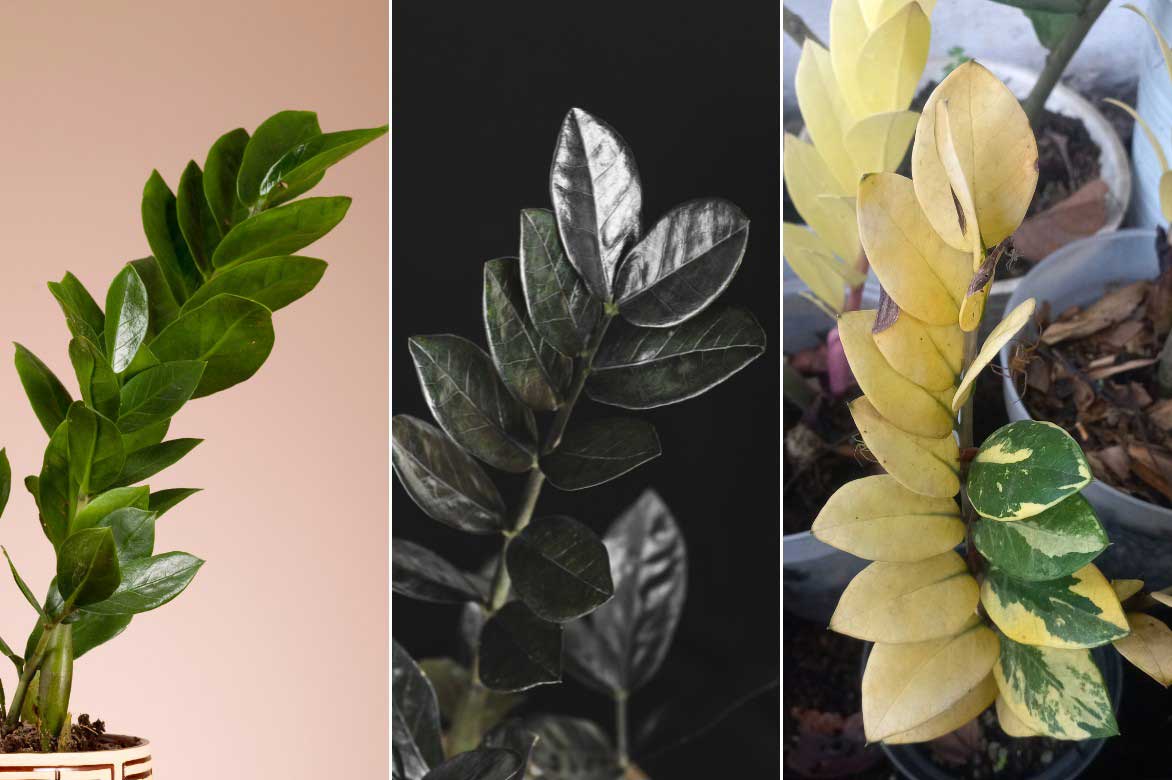
Zamioculcas comes in different varieties, with green foliage (Zamioculcas zamiifolia), black (Zamioculcas ‘Raven’) or variegated with yellow.
Note: Zamioculcas secretes a slightly toxic sap when injured. It can cause skin irritations or digestive issues if ingested (especially in pets). It is therefore advisable to handle it with gloves and keep it out of reach of children and animals.
“`
The main species and varieties
Planting Zamioculcas
Where to install Zamioculcas?
Zamioculcas is a highly adaptable indoor plant, capable of acclimatising to various types of spaces. However, it prefers certain conditions to express its full potential. The ideal is to place it in bright, indirect light. It tolerates semi-shade well, making it an excellent choice for poorly lit rooms, such as hallways or north-facing offices. However, too little light will slow its growth, and new shoots will be less vigorous.
It is essential to protect it from direct sunlight, especially in summer, as its leaves can scorch under intense rays. The perfect spot is therefore near a shaded or lightly filtered window, or in a room facing east or north, where the light is soft and diffuse. The Zamioculcas thrives at a temperature between 18 and 25 °C. It begins to suffer once temperatures drop below 10 °C, making it unsuitable for outdoor cultivation in temperate climates.
Another advantage of this plant is that it does not require particular humidity. It tolerates dry atmospheres very well, making it an ideal plant for heated interiors, especially in winter.
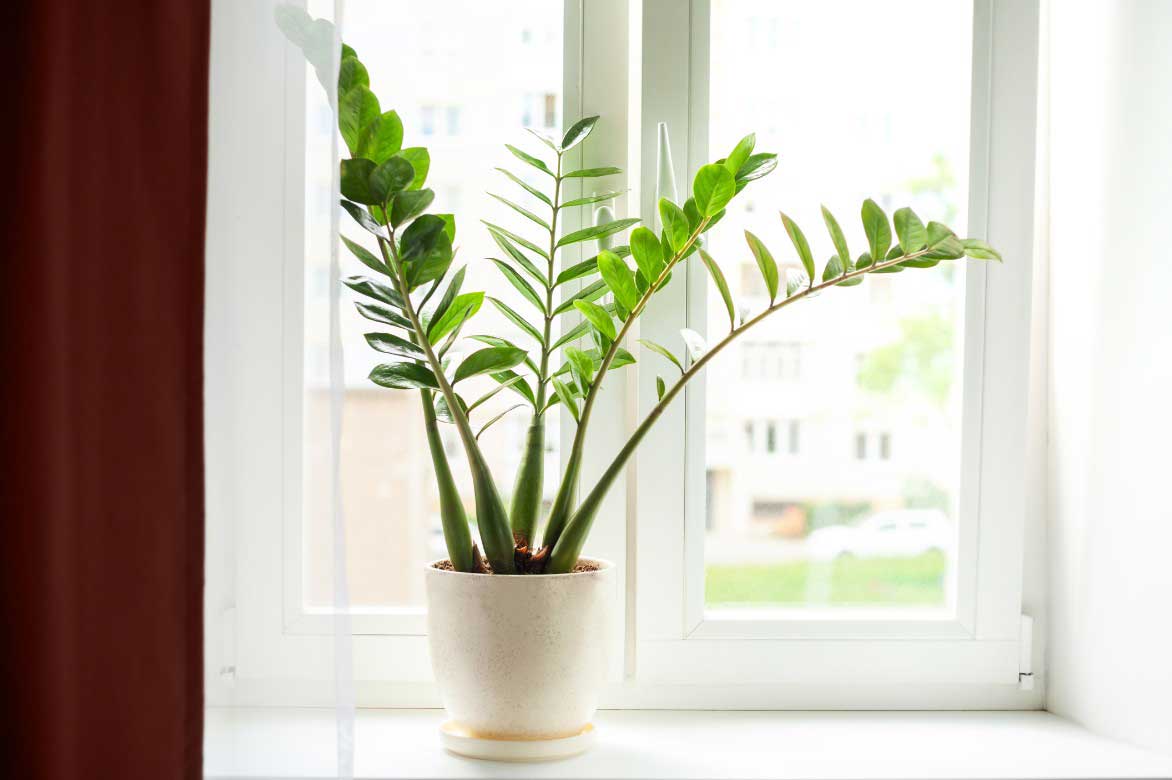 Place the Zamioculcas in a bright spot, but out of direct sunlight, for example near a north or east-facing window.
Place the Zamioculcas in a bright spot, but out of direct sunlight, for example near a north or east-facing window.
When to plant?
Planting or repotting Zamioculcas is best done in spring, between March and May. This is when the plant enters its active growth phase and will better tolerate handling.
How to plant?
Here are the steps to follow for planting or repotting the ZZ plant:
- Choose the right pot: opt for a pot with drainage holes, as the Zamioculcas does not tolerate standing water. Terracotta pots are perfect as they allow the roots to breathe.
- Prepare the substrate: use a well-draining mix, such as potting soil for green plants mixed with sand, perlite, or pumice.
- Install drainage: place a layer of clay balls or gravel at the bottom of the pot to prevent excess moisture.
- Plant: gently remove the plant from its original pot without damaging the rhizomes. Place it in the centre of the new pot, then fill around it with substrate, pressing down lightly.
- Watering after planting: water lightly after planting, then allow the substrate to dry before the next watering. The Zamioculcas prefers a bit of dryness to excess water.
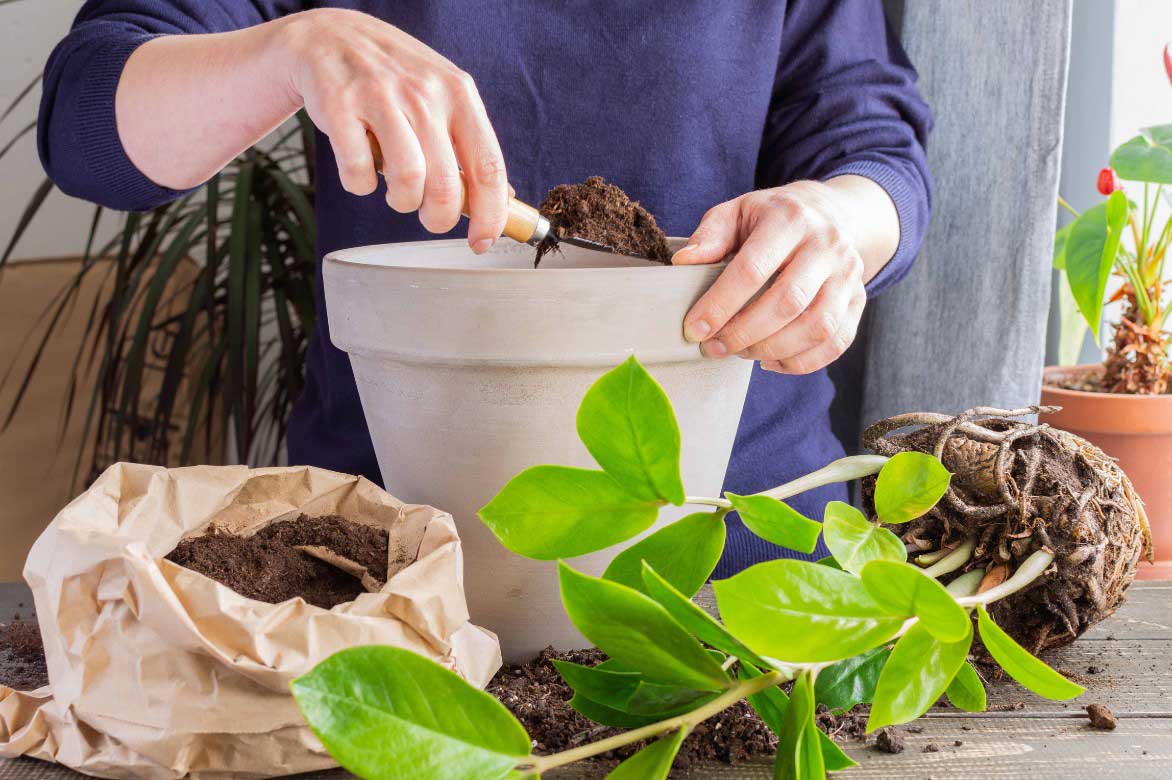
How to care for Zamioculcas?
Zamioculcas is renowned for its ease of care. It requires little attention and easily forgives neglect. This makes it a perfect plant for beginner gardeners or those with a busy lifestyle. Here are the essential steps to keep it in great shape:
Watering
Zamioculcas requires moderate watering. This plant tolerates drought very well but fears excess water. Its fleshy rhizomes store moisture, allowing it to survive long periods without watering. In spring and summer, watering every two to three weeks is generally sufficient, ensuring the substrate dries out between waterings. In autumn and winter, monthly watering may suffice, as the plant slows its growth and consumes less water. The main mistake to avoid is overwatering.
Tip: if the leaves start to yellow or soften, this may indicate overwatering.
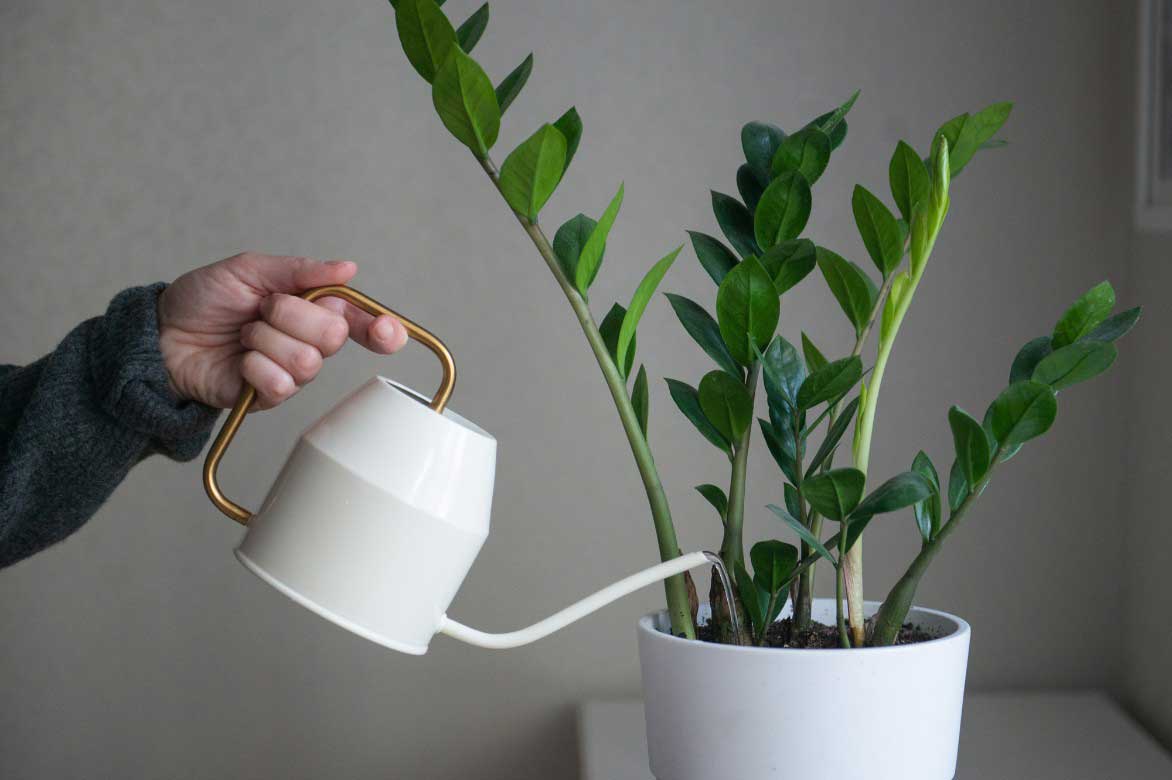
Fertiliser
A moderate application of fertiliser can be beneficial during the growth period, from March to September. You can use a liquid fertiliser for green plants, diluted to half strength, applied every 4 to 6 weeks.
Leaf cleaning
We recommend regularly dusting the leaves with a soft, damp cloth to maintain their natural shine. Shiny products should be avoided, as they can clog the stomata.
Pruning
Zamioculcas does not really need pruning, but you can cut damaged, dried, or yellowing stems back to their base with clean pruning shears.
Repotting
Repot Zamioculcas every two to three years, when the rhizomes begin to completely fill the pot. Spring is the ideal time for this operation, which also allows for substrate renewal.
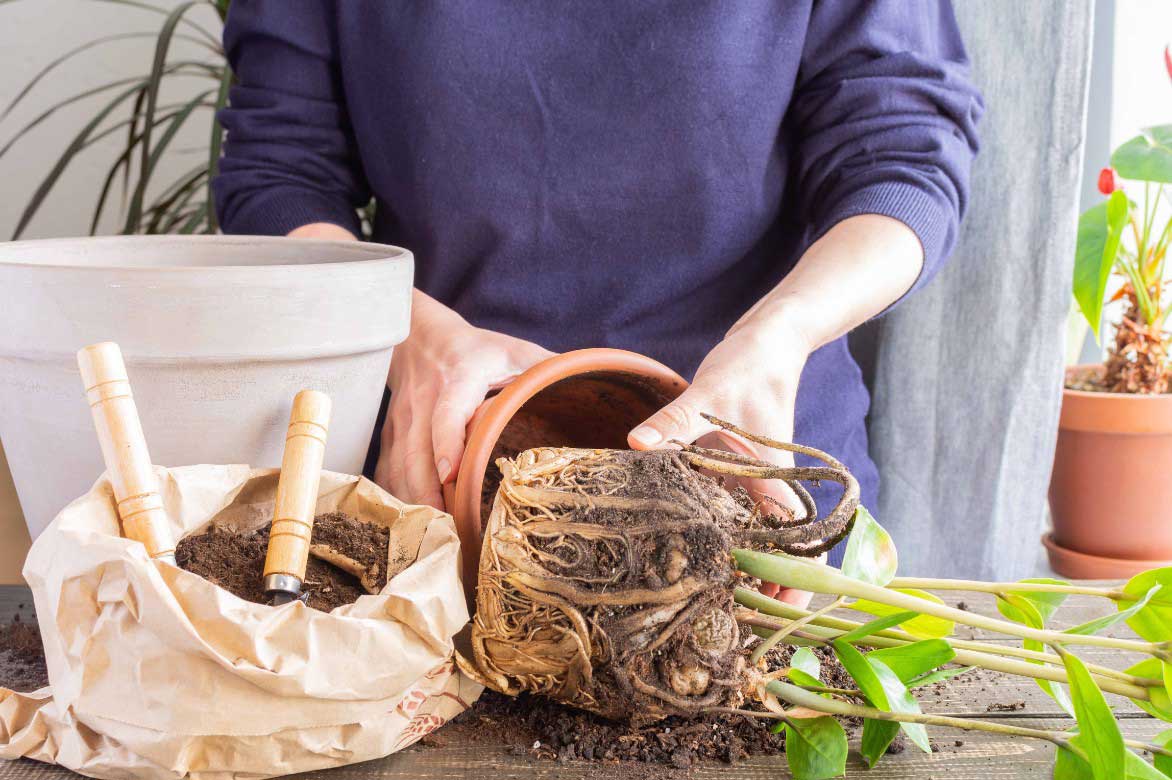
Here you can see that the roots are very dense and have no room to grow. This Zamioculcas therefore needs to be repotted into a larger pot.
Diseases and pests
Zamioculcas is a robust plant, not particularly prone to diseases and pest attacks. However, like any plant, it can encounter some issues, especially when the growing conditions are not ideal.
Pests
Zamioculcas can sometimes be attacked by mealybugs or red spider mites. Mealybugs appear as small cottony masses (woolly mealybugs) or small brown shells (scale insects). They can be removed manually with a cotton ball soaked in 90° alcohol or soapy water. As for red spider mites, they mainly appear when the air is too dry. Regular misting can prevent their occurrence, and in case of an infestation, you can treat with rosemary essential oil. For this, mix 20 to 25 drops of essential oil with 3 or 4 drops of liquid black soap and 5 ml of rapeseed oil. Dilute everything in 1 litre of water and spray on the foliage.
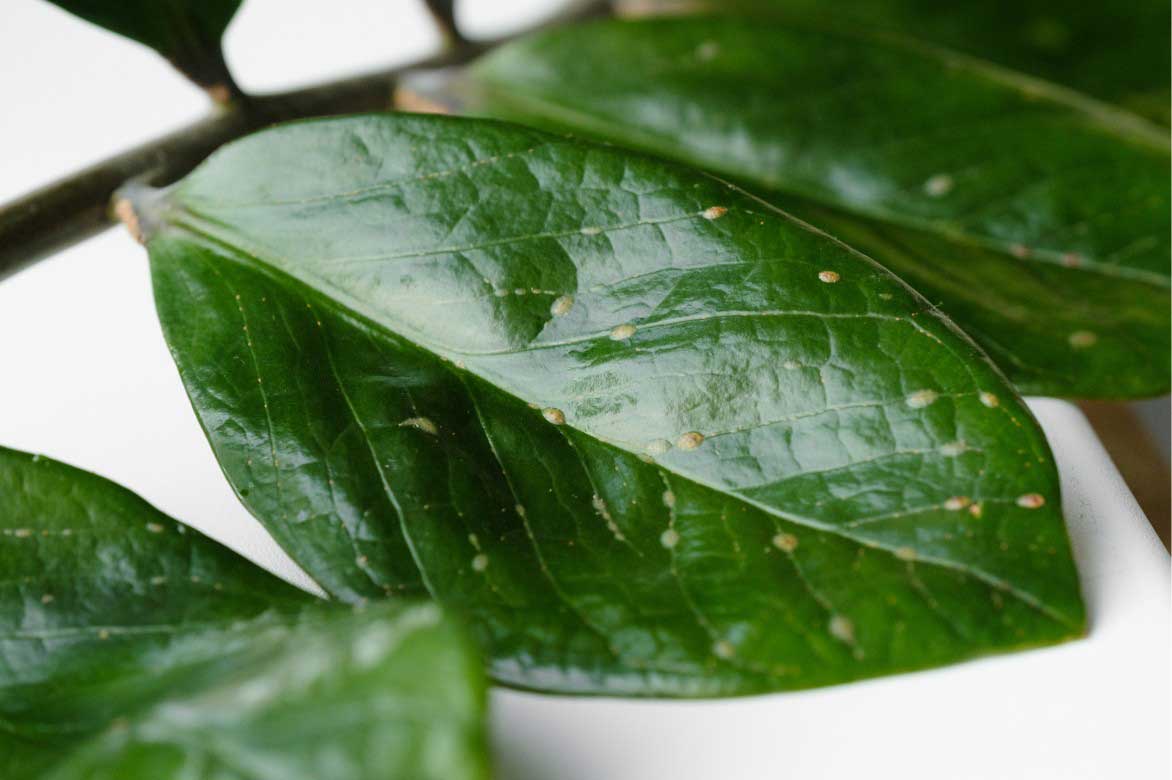 A Zamioculcas infested with scale insects
A Zamioculcas infested with scale insects
Root rot
The main problem that Zamioculcas may face is root rot, almost always caused by overwatering. If the leaves start to yellow and the stems become soft at their base, it is essential to check the condition of the substrate immediately. Waterlogged soil or an unpleasant smell are serious indicators. You should then remove the plant from its pot, cut away the damaged parts, and repot it in a healthy, well-draining mix.
Other cultivation issues
Besides watering, a lack of light can also weaken the plant, although the signs may be less obvious. The leaves may lose their vibrancy or stretch towards the light. In this case, it is often sufficient to move the plant to a brighter location, while avoiding direct sunlight.
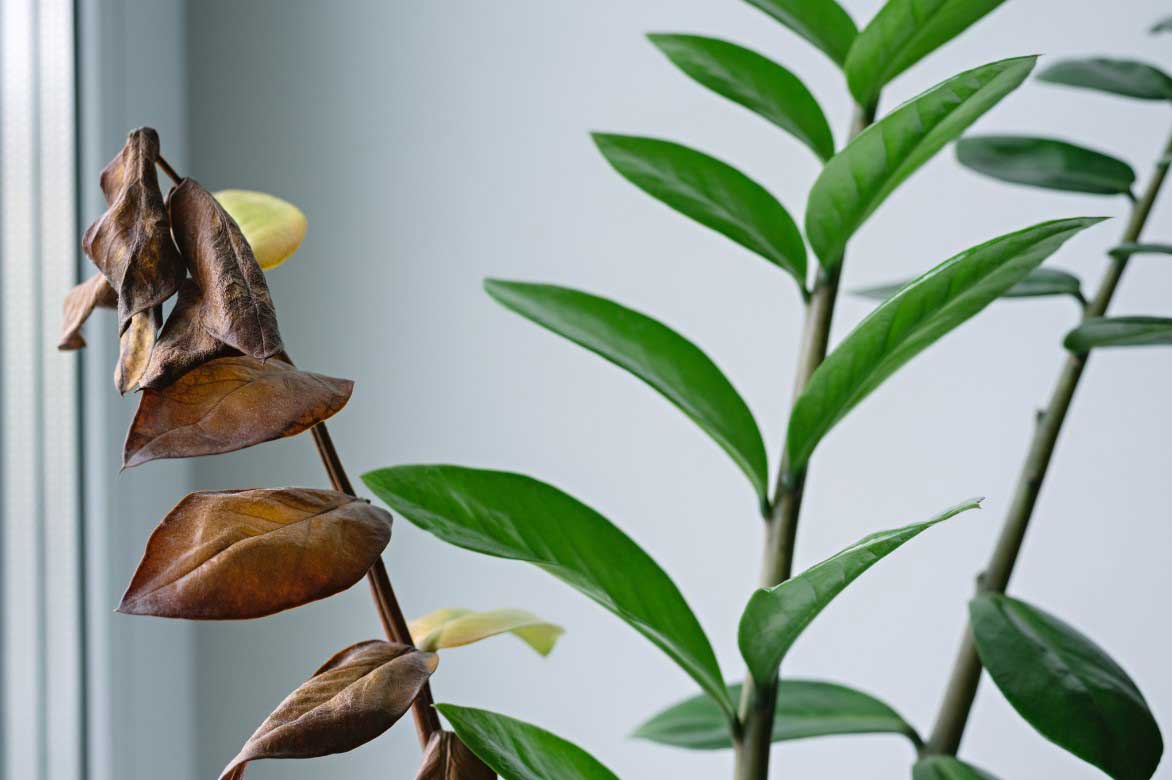 Dried leaves on a Zamioculcas. This may be due to root rot caused by excess moisture.
Dried leaves on a Zamioculcas. This may be due to root rot caused by excess moisture.
How to propagate Zamioculcas?
There are two main techniques for propagating Zamioculcas: clump division and propagation by cuttings. Division is quicker and particularly suitable if you have a well-developed Zamioculcas plant that is starting to feel cramped in its pot. This will give it more space to grow and rejuvenate the clump.
Propagating Zamioculcas by clump division
When to divide Zamioculcas?
It is best to intervene at the time of repotting, ideally in spring.
How to do it?
- Remove the plant from its pot and gently remove the soil around the roots to make them visible.
- Carefully separate the roots, ensuring that at least one leafy stem is kept per section.
- Replant each division in a new pot with well-draining substrate.
- Water lightly and place in indirect light.
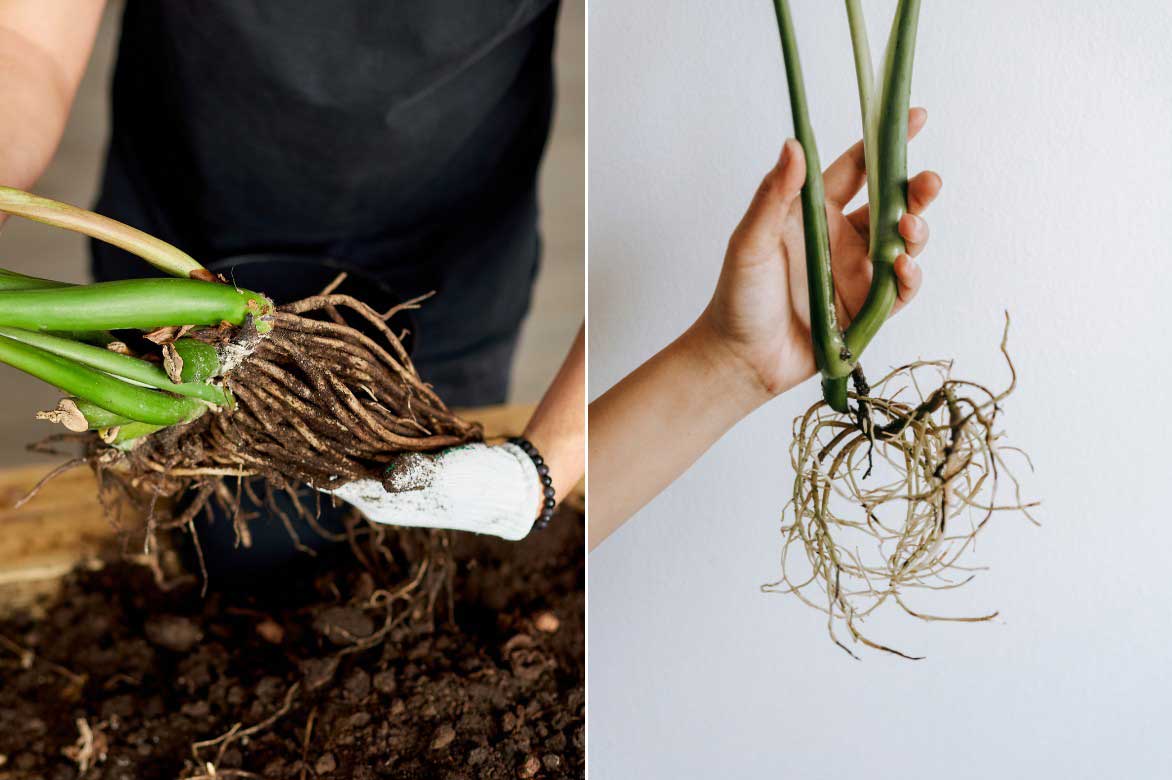 To divide Zamioculcas, remove the plant from its pot, clear the excess soil around the roots, and take a section with enough roots to ensure its recovery.
To divide Zamioculcas, remove the plant from its pot, clear the excess soil around the roots, and take a section with enough roots to ensure its recovery.
How to propagate Zamioculcas by cuttings?
This is a slower method, but very rewarding! You can propagate Zamioculcas in water or directly in a pot.
Steps:
- Choose a healthy, vigorous stem that shows no signs of disease.
- Cut it at the base using a sharp knife or pruning shear.
- You can then either plant the stem in a pot filled with a light mix (potting soil + perlite or sand) or place it in a container with water (for example, a glass or a small jar). Propagating in water allows you to monitor root development.
- Place the cutting in a warm, bright location, out of direct sunlight.
- Be patient… It may take several months for mini-rootstocks and shoots to appear!
- If you propagated Zamioculcas in water, transplant the cutting into a pot with potting soil as soon as it has produced a few roots.
Whichever method you choose, be patient! Zamioculcas takes time to develop its roots and rootstocks. But once established, the new plant will be as robust as its mother plant.
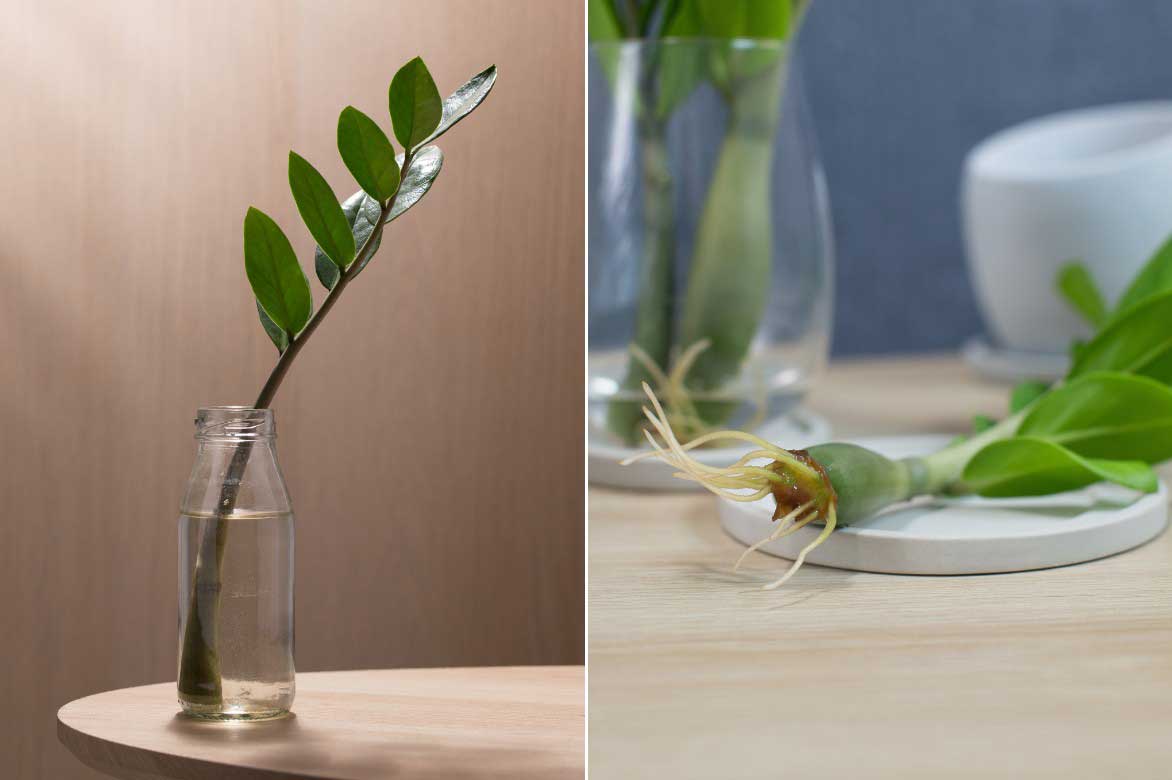 You can propagate Zamioculcas in water, then transplant the cutting into a pot as soon as it has produced a few roots.
You can propagate Zamioculcas in water, then transplant the cutting into a pot as soon as it has produced a few roots.
How to showcase Zamioculcas and which plants to pair it with?
Zamioculcas is a plant with a structured habit and glossy foliage that easily integrates into many styles of decor. It pairs particularly well with other green plants that have complementary characteristics. For example, the combination with a Monstera deliciosa creates a stunning contrast between the cut foliage of the monstera and the smooth, regular leaves of Zamioculcas. In the same spirit, a Pothos with long, flexible, trailing stems can soften the rigid lines of Zamioculcas while adding movement to the overall display. Chlorophytums, or spider plants, offer light, trailing foliage that creates a lovely contrast with the verticality of Zamioculcas.
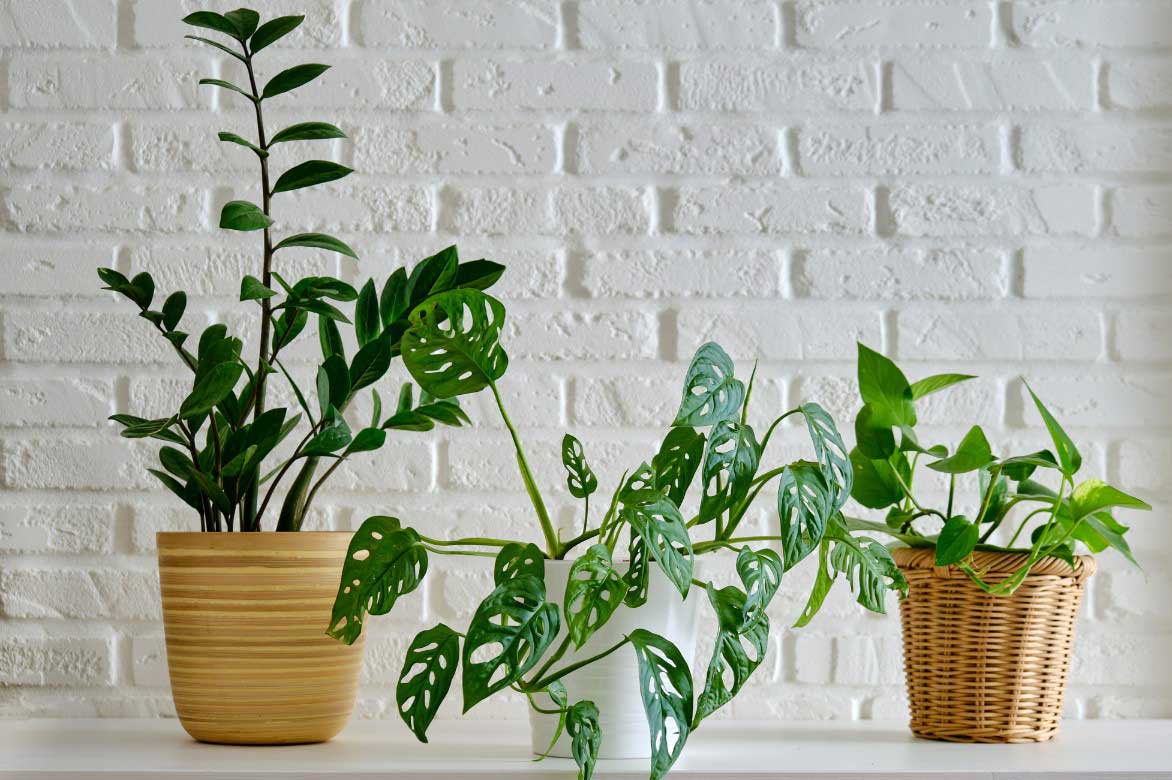
Zamioculcas, Monstera and Pothos
Other combinations work very well, particularly with Sansevieria, also known as mother-in-law’s tongue. This plant, with its upright and rigid foliage, shares the same light and watering needs, making it an ideal partner. Calathea and Maranta, with their veined and often colourful leaves, add a touch of exoticism and whimsy that breaks the sobriety of Zamioculcas. One might also consider pairing it with a Ficus elastica or a Ficus lyrata, whose large, glossy leaves form a lush backdrop, or with an Aspidistra for a more classic and understated ambiance.
In interior decor, Zamioculcas lends itself very well to modern and minimalist atmospheres. It is often used in Scandinavian-style interiors, where its clean lines and dark green foliage contrast elegantly with the light tones of the furniture. Placed in a rattan, raw terracotta, or matte ceramic pot, it perfectly complements a zen, minimalist, or even industrial decor. In an office or coworking space, it adds a natural and structured touch without taking up too much space or requiring much care. Positioned alone in a large pot, it can become a focal point or blend discreetly into a larger plant composition.
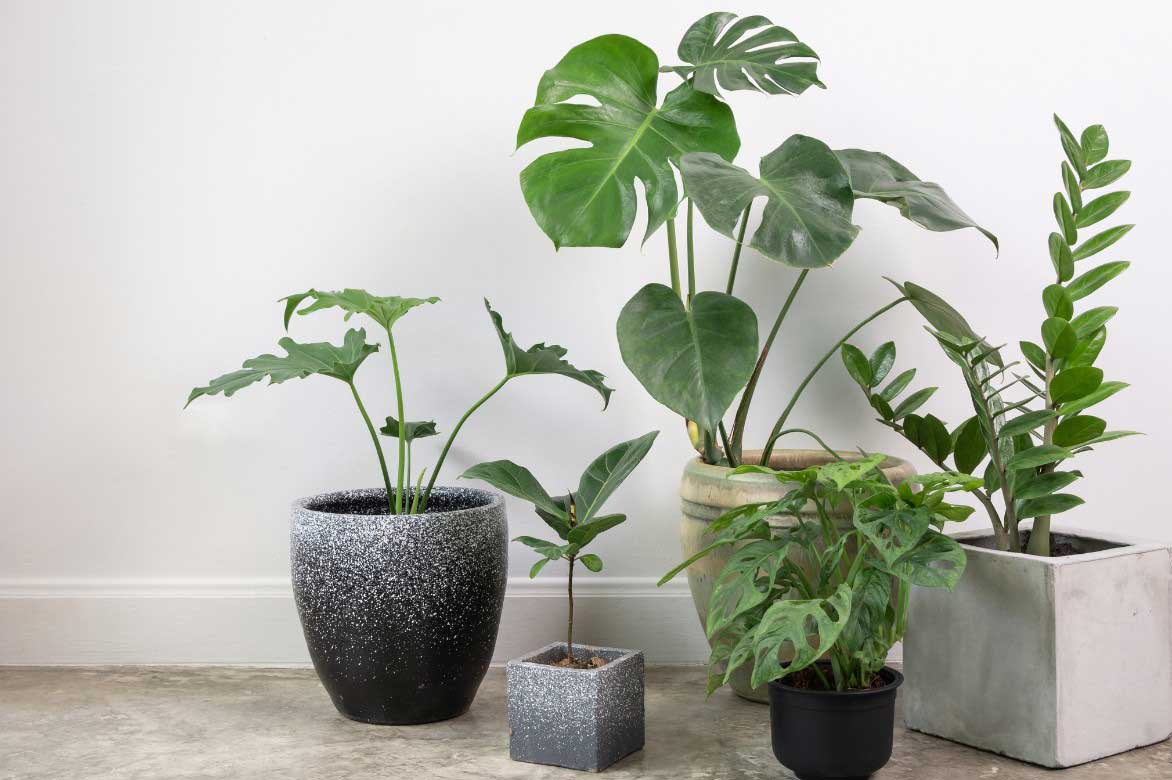
Philodendron selloum, Ficus lyrata, Monstera and Zamioculcas zamiifolia
- Subscribe!
- Contents
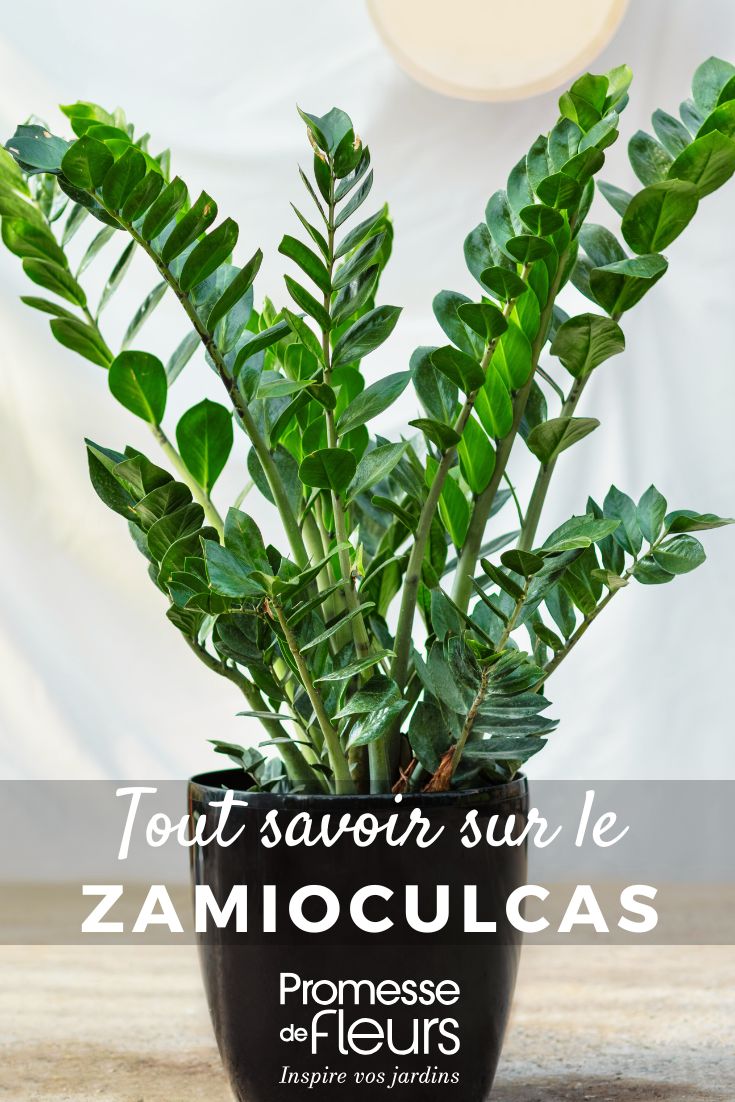































Comments